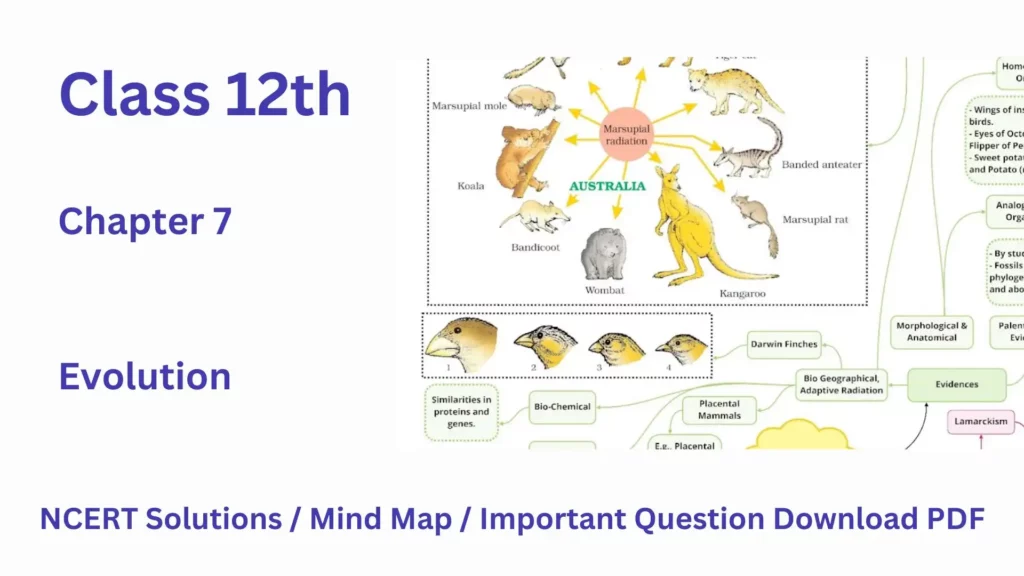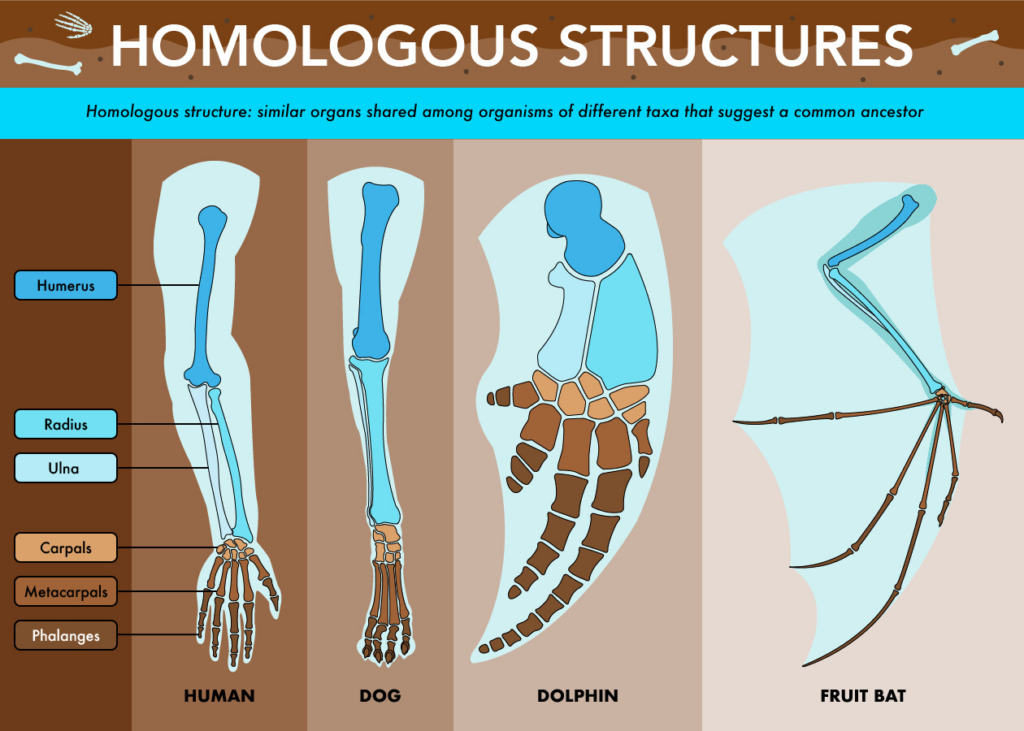NCERT Solutions, Question Answer and Mind Map for Class 12 Biology Chapter 7, “Evolution,” is a comprehensive study material package that covers the principles and mechanisms of evolution.
The NCERT Solutions provide detailed explanations and answers to the questions presented in the chapter. The solutions cover all the topics in the chapter, including the definition and types of evolution, evidence for evolution, and the role of natural selection in evolution. They also provide tips on how to answer different types of questions, including short answer, long answer, and multiple-choice questions.

The question-answer section of the chapter covers a wide range of topics, from the difference between microevolution and macroevolution to the mechanisms of genetic drift and gene flow. It also includes questions on the evidence for evolution, such as the fossil record, biogeography, and comparative anatomy.
The mind map provides a visual representation of the key topics covered in the chapter, allowing students to understand the connections between different concepts and ideas. The mind map covers the different types of evolution, the mechanisms of natural selection, genetic drift and gene flow, and evidence for evolution.
NCERT Solution Class 12 Biology Chapter 7 Evolution Download PDF
Origin of Life:
- The origin of life is considered unique events in the history of universe. Huge cluster of galaxies comprises the universe. Galaxies contain stars and clouds of dust and smoke.
- Big Bang Theory attempts to explain the origin of universe. According to this theory, a huge explosion occurs that forms the different galaxies.
- In solar system of Milky Way galaxies, earth has been supposed to be formed about 4.5 billion years ago. There was no atmosphere in early earth. Water vapour, methane, carbon dioxide and ammonia released from molten mass covered the earth surface.
- UV rays from sun splits the water into hydrogen and oxygen. Life appeared 500 million years after the formation of earth.
There are different theories regarding the origin of life on earth:
- Some scientist believes that life comes from other planets. Early Greek thinker thoughts that unit of life is called spores transferred from other planets.
- According to other theory, life comes out of dead and decaying matters like straw and mud. This theory is called theory of spontaneous origin.
- Louis Pasture experimentally proved that life arises only from pre-existing life. Spontaneous theory of origin of life is dismissed after that.
- Oparin and Haldane proposed that the first form of life could have come from pre-existing non-living organic molecules like RNA and protein etc. The formation of life preceded by chemical evolution. At that time condition on earth were- high temperature, volcanic eruption, reducing atmosphere containing CH4 and NH3.
Experimental representation of Miller’s experiment:
- Miller experiment of Origin of Life- S.L. Miller in 1953, conducted an experiment to show the origin of life on earth in the physical environment similar to condition prevails at that time.
- Miller created similar condition of temperature and pressure in laboratory scale. He created electric discharge in a flask containing CH4, H2 and NH3 and water vapour at 8000C.
- He observed formation of amino acids in flask after 15 days of electric discharge. Similar experiment by other scientist found formation of sugars, nitrogen bases, pigments and fats.
- Analysis of meteorite content also reveals similar compounds that reveal that similar process are occurring elsewhere in the space. This experimental evidence about the origin of life is called chemical evolution of life.
- The first non-cellular forms of life could have originated 3 billion years back. They could have been giant molecules like RNA, Protein, and Polysaccharide etc.
- The cellular form of life was probably single cell and originates in water medium. The theory that first form of life arose slowly through evolutionary forces from non-living molecules is called biogenesis.

Darwin Theory & Natural Selection:
Charles Darwin concluded that existing living forms share similarities to varying degrees not only among themselves but also with life forms that existed millions of years ago. Many such life forms do not exist anymore. There has been gradual evolution of life forms. according to Darwin, refers ultimately and only to reproductive fitness. those who are better fit in an environment, leave more progeny than others. will survive more and hence are selected by nature. He called it natural selection Alfred Wallace, a naturalist who worked in Malay Archepelago had also come to similar conclusions around the same time. All the existing life forms share similarities and share common ancestors. The geological history of earth closely correlates with the biological history of earth.
Evidence of Evolution:
Evidence that evolution of life forms has taken place on earth have many proofs as mentioned below:
Paleontological evidence:
Paleontological evidence different aged rock sediments contain fossils of different life forms that probably died during the formation of particular sediment. Fossils are remains of hard parts of life-forms found in rocks. The study showed that different form varied over time and certain life forms are restricted geological time span. Hence, new forms of life have arisen at different times in history of earth.

Homologous organs: Homologous organs those organs that perform different function but have similar origin and structure are called homologous organs. For e.g. human, cheetah, bat and whales share similarities in pattern of bones of forelimbs although these forelimbs perform different functions in these animals. In these animal similar structure developed along different directions due to adaptation of different needs. This is called divergent evolution.
Homologous structures: Homologous structures are organs or skeletal elements of animals and organisms that, by virtue of their similarity, suggest their connection to a common ancestor. These structures do not have to look exactly the same, or have the same function. The most important part, as hinted by their name, is that they are structurally similar.

Analogous Structures: Bird, Insect and Bat Wings. Unlike creatures with homologous structures, where organisms’ shared traits can determine a Fish and Penguin Fins/ Flippers. Fish and penguins are both vertebrates that use fins to swim in deep waters. However, Duck and Platypus Bills. The duck-billed platypus, which is a mammal, seems like a perplexing example of evolution.

Biochemical evidences:
Similarities in proteins and genes performing a given function among diverse organisms give hints to common ancestry. These biochemical similarities point to the same shared ancestry as structural similarities among diverse organisms.
Divergent Evolution: Development of different functional structures from a common ancestral form is called divergent evolution. Homologous organs show divergent evolution Examples: Darwin’s Finches, Australian Marsupials, locomotion in mammals.
Convergent Evolution: Development of similar adaptive functional structures in unrelated groups of organisms is called convergent evolution. Analogous organs show convergent evolution examples: Australian Marsupials and Placental mammals, various aquatic vertebrate and wings of insect bird and bat.
Adaptive Radiation:
The process of evolution of different species in given geographical area starting from a point and radiating to other areas of geography (habitat) is called adaptive radiation. Darwin’s finches represent one of the best examples of adaptive radiation. Australian marsupials, each with different from other evolved from one ancestral stock, but all within Australian island continents.

When more than one adaptive radiation appeared to have occurred in an isolated geographical area (representing different habitats), we can call this convergent evolution e.g. Placental mammals and Australian marsupials.
Biological Evolution:
The nature select for fittest and fitness is based on characteristics which are inherited. Some organisms are better adopted to survive in otherwise hostile environment. Fitness is the end result of the ability to adopt and get selected by nature.
Lamarck had said that evolution of life form had occurred but driven by use and disuse of organs. He gave the example of giraffe to evolve their neck by foraging leaves on tall trees and had to adapt by elongation of their necks.
Branching descent and natural selection are the two key concepts of Darwinian Theory of Evolution.
Darwin theory of natural selection was based on certain observations like:
- Limited natural resources.
- Over population
- Competition for resources
- Struggle for existence
- Survival of the fittest.
Mechanism of Evolution:
Hugo DeVries based on his work on evening primrose brought forth the idea of mutation. Mutation is the large difference arising suddenly in a population.
Mutations are random and directionless while Darwin variations are small and directional. Hugo DeVries believed that mutation causes speciation and hence called saltation (single step large mutation).
Hardy Weinberg Principle:
Hardy Weinberg Principle in a given population, frequency of occurrence of alleles or genes can be finding out. These frequencies remains fixed and even remain the same through generation. This fact was represented by Hardy-Weinberg principles using algebraic equation.
This principle states that allele frequencies in a population are stable and is constant from generation to generation. The gene pool remains constant. This is called genetic equilibrium and sum total of all the allelic frequencies is 1.
Binomial expansion of (p + q)2 = p2 + 2pq + q2 = 1 where p and q represent the frequency of allele A and allele a in a population. The frequency of AA individuals in a population is simply p2. This is simply stated in another ways, i.e., the probability that an allele A with a frequency of p appear on both the chromosomes of a diploid individual is simply the product of the probabilities, i.e., p2. Similarly of aa is q2, of Aa 2pq. Hence, p2 + 2pq + q2 = 1.
When frequency is measured, the actual value varies that indicates the extent of evolutionary changes. Change of frequency in a allele (Hardy-Weinberg equilibrium) in a population resulted due to evolution.
The factors that affect Hardy-Weinberg equilibrium are:
- Gene migration or gene flow.
- Genetic drift
- Mutation
- Genetic recombination
- Natural selection.
- During genetic drift, sometimes change in alleles frequency is so different in a sample of population that they become a different species. The original drifted population becomes founder and that effect is called founder effect.

Origin and evolution of man:
About 15 mya, primates called Dryopithecus and Ramapithecus were existing. Hairy walk like gorillas Ramapithecus was more man-like while Dryopithecus was more ape-like. about 3-4 mya, man-like primates walked in eastern Africa taller than 4 feet walked right Australopithecines probably lived in East African ate fruit. This creature was called the first human-like brain capacities 650-800cc. Homo erectus large brain around 900cc ate meat. Homo sapiens brain size of 1400cc.

NCERT Solution for Class 12 Biology Chapter wise
- Chapter 1 Reproduction in Organisms
- Chapter 2 Sexual Reproduction in Flowering Plants
- Chapter 3 Human Reproduction
- Chapter 4 Reproductive Health
- Chapter 5 Principles of Inheritance and Variation
- Chapter 6 Molecular Basis of Inheritance
- Chapter 7 Evolution
- Chapter 8 Human Health and Disease
- Chapter 9 Strategies for Enhancement in Food Production
- Chapter 10 Microbes in Human Welfare
- Chapter 11 Biotechnology: Principles And Processes
- Chapter 12 Biotechnology and its Applications
- Chapter 13 Organisms and Populations
- Chapter 14 Ecosystem
- Chapter 15 Biodiversity and Conservation
- Chapter 16 Environmental Issues
